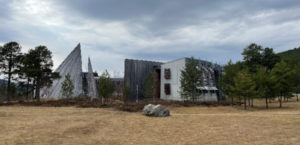In April and May 2023, Jacqueline Götze, IDOS researcher in the DFG-funded research project on “Sustainable Urban Development in the European Arctic (SUDEA)”, visited the Centre for Sámi Studies at the Arctic University of Norway (UiT) as a guest researcher.

The Sámi Parliament in Norway ©Jacqueline Götze
Tromsø/Romsa is one out of seven case study cities the SUDEA team investigates with view to questions of transnational cooperation and sustainable urban development. At UiT, Jacqueline Götze worked closely with Professor Else Grete Broderstad, an expert in Sámi-state relations with a focus on political representation of the Sámi people in the Nordics. In the relations between the EU and the Sámi people, the nation-states play a relevant role and can shape how Sámi organisations interact with EU institutions. Jacqueline Götze presented her PhD research on Sámi participation at the EU level in different exchanges at the transdisciplinary centre. She also met with representatives from the Sámi Parliament in Norway, the Arctic Indigenous Peoples Secretariat and the Norwegian Institute for Cultural Heritage Research to discuss results of her work. The exchange with voices from Norway as a non-EU member state but with rising relevance for EU’s energy supply and linked effects on (traditional) land uses helped to contextualise preliminary results from her research.
In addition to the research stay in Tromsø/Romsa, she visited the Sámi Parliaments in Norway (Karasjok/Kárášjohka) and in Finland (Inari/Anár) as well as the important site of Alta/Álaheadju (Finnmark, Norway) for further data collection. Alta stands for Sámi resistance against state’s influence on traditional land uses and livelihoods. In the 1960s and 1970s, Alta became a symbol for a changing Sámi agency due to plans to build a hydropower dam in the region. The Alta case led to Sámi institution-building, amendments in the Norwegian Constitution to acknowledge the Sámi as an Indigenous people and changed the relationship between the state and the Sámi people in the Nordics completely since the changes on the Norwegian part of Sápmi also influenced Sámi rights and representation in the Swedish and Finnish side of Sápmi.
Also Tromsø/Romsa, a harbour city located around 350km north of the Arctic Circle, belongs to Sámi homeland (Sápmi), the traditional area of the Indigenous People in the northern parts of Norway, Sweden, Finland, and the Kola Peninsula in Russia. The number of inhabitants has significantly grown in the past decades. In this international city people from 139 nations live together. The city hosts the largest university of the region and also many other research institutes, the Arctic Council’s Secretariat and an office of the Sámi Parliament in Norway, which makes the Tromsø/Romsa an interesting case to investigate transnational cooperation formats. In its rich offers in the cultural scene, one can experience Sámi cultures, traditions, political institution-building and learn more about the (post)colonial relations with the state. Tromsø/Romsa is presenting itself as the gateway to the Arctic and became a popular tourist destination with continuous growing airborne tourism, which has changed the character of the traditional fishing town and also impacts life in the city. With regards to sustainable urban development, not everyone sees the increased number of tourists as positive and some feel that the city is being more designed to satisfy the needs of tourists thanthose of citizens, while others depend on the income generated by the tourism sector. Together with Oslo, Tromsø/Romsa is the most expensive city when it comes to property prices and rents in whole Norway, which describes the circumstances that many people are dependent on tourism since they are utilising for instance Airbnb offers to finance their own houses and flats.
